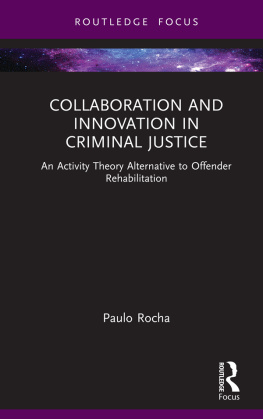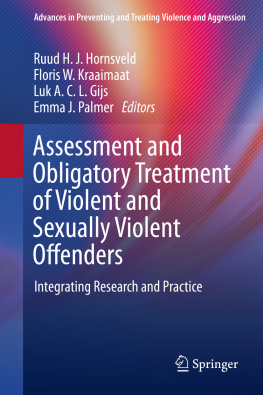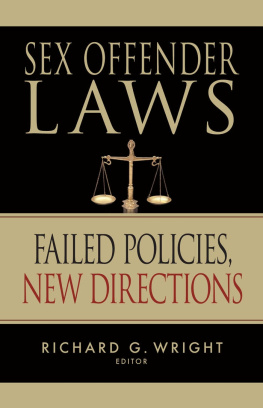The Sex Offender Housing Dilemma
The Sex Offender Housing Dilemma
Community Activism, Safety, and Social Justice
Monica Williams
NEW YORK UNIVERSITY PRESS
New York
NEW YORK UNIVERSITY PRESS
New York
www.nyupress.org
2018 by New York University
All rights reserved
Portions of this book are adapted from Monica Williams, Constructing Hysteria: Legal Signals as Producers of Siting Conflicts over Sexually Violent Predator Placements, Law and Social Inquiry. 2016. Epub ahead of print. doi: 10.1111/lsi.12265.
References to Internet websites (URLs) were accurate at the time of writing. Neither the author nor New York University Press is responsible for URLs that may have expired or changed since the manuscript was prepared.
Library of Congress Cataloging-in-Publication Data
Names: Williams, Monica (Sociologist), author.
Title: The sex offender housing dilemma : community activism, safety, and social justice / Monica Williams.
Description: New York : New York University Press, [2018] | Also available as an ebook. | Includes bibliographical references and index.
Identifiers: LCCN | ISBN 978-1-4798-9711-7 (cl ; alk. paper) | ISBN 1-4798-9711-6 (cl ; alk. paper) | ISBN 978-1-4798-3649-9 (pb ; alk. paper) | ISBN 1-4798-3649-4 (pb ; alk. paper)
Subjects: LCSH: Sex offendersHousingCalifornia. | Sex offendersLegal status, laws, etc.California. | Sex offendersRehabilitationCalifornia. | Community activistsCalifornia. | Sex offendersHousingUnited States. | Sex offendersLegal status, laws, etc.United States. | Sex offendersRehabilitationUnited States. | Community activistsUnited States.
Classification: LCC HV6592 .W54 2018 | DDC 363.5/9692709794dc23
LC record available at https://lccn.loc.gov/2017034140
New York University Press books are printed on acid-free paper, and their binding materials are chosen for strength and durability. We strive to use environmentally responsible suppliers and materials to the greatest extent possible in publishing our books.
Manufactured in the United States of America
10 9 8 7 6 5 4 3 2 1
Also available as an ebook
For Matthew, without whom this book would never have been possible
Contents
Figures
Figure 1.1. Percentage of Communities Engaged in Different Response Strategies
Figure A1. Case Selection Strategy
Tables
Table 1.1. Demographics of Communities That Received or Were Proposed to Receive an SVP Placement in California from 2003 through 2014
Table 5.1. Community Orientations to Political Authority
Table 5.2. Community Orientations to Legal Authority
Table A1. Characteristics of SVP Siting Conflicts and Local Populations
Table A2. Sample Demographics
Table A3. Position Titles of Officials Interviewed
In Washington State, Tammy Gibson beat a sex offender with a baseball bat after receiving notification that he had moved into her neighborhood.
While media accounts would have us believe that vigilantes across the country lie in wait for sex offenders who move into their neighborhoods, responses to sex offenders more often involve collective, nonviolent political and legal actions. For instance, communities across the nation have built tiny pocket parks in neighborhoods where local ordinances prohibit sex offenders from living near schools or parks. These types of responses to sex offender housing proposals may be more socially desirable than vigilantism, but they still pose severe challenges to sex offenders trying to reintegrate into society.
This book focuses on the problem of finding housing for sex offenders. The public has little sympathy for these offenders, but a lack of social supports and stable housing can increase the likelihood of reoffending.
Community notification laws exacerbate the situation. These laws require law enforcement to notify the public about some types of sex offenders, with the assumption that doing so will enable communities to keep themselves safe. Ironically, community notification may have the opposite effect. Those who receive notification do not appear to engage in self-protective behaviors. Instead, community notification laws appear to make it harder for those identified as sex offenders to find places to live.
Repealing empirically unfounded laws would be a step in the right direction, but sex offenders returning to society after incarceration would still face problems associated with their stigmatized status. The Tammy Gibsons of the world and the less violent but just as damaging people who band together to keep sex offenders out of their neighborhoods would continue to create major obstacles to reintegration. Beyond laws and policies, the everyday realities of trying to find housing for a highly stigmatized and feared group of people make the problem seem almost insurmountable. Where should these offenders go? How can we facilitate their successful reintegration into communities? How do we balance individual rights with public safety when trying to find housing? These suggestions warrant serious consideration, but we cannot solve the problem of sex offender housing without looking closely at how and why communities oppose sex offenders in their neighborhoods. This book takes on this task by examining community opposition to SVP placements in California.
On the surface, local protests against sex offenders seem to reflect a simple not-in-my-backyard (NIMBY) attitude. Closer examination reveals more complex issues. As Tammy Gibson assaulted the sex offender in Washington, she reportedly told him, If it were up to me, Id kill ya. For these individuals, justice required working outside of the law to protect children and other vulnerable populations from sex offenders, which suggests skepticism of how formal institutions deal with these offenders.
Similar concerns emerge in the more common, nonviolent community responses to sex offenders. One such response occurred one evening in April 2009 when community members in an unincorporated town in Monterey County learned of the proposed placement of an SVP in their town. I attended the community notification meeting to see how community members and local officials managed this potentially volatile situation. When I arrived at the local winery that was hosting the meeting, people milled about the gravel parking lot and reception hall discussing what they had heard about the SVP who might soon be moving into their neighborhood. I sat in a folding chair next to a burly man who lived on the same road on which state officials had proposed the SVP placement. The man worked for a winery equipment business, and he told me that the community had never before faced anything like the proposed SVP placement.
The audience generally quieted, but one man quickly interrupted the introductions, demanding that they eliminate the bullshit and get to the questions. The county supervisor, trying to maintain order, assured him there would be an opportunity for public comment in due time. After a brief exchange between the two men, order prevailed. Panel members made their introductions and then provided some information about the placement.
When it came time for public comment and questions, one audience member questioned the legality of the judges decision to place the SVP in the neighborhood. The supervisor answered that the decision was probably legal, but that he was not a legal expert and that we were not there to debate the judges ruling. Instead, he said, the purpose of the meeting was to figure out how to move forward. After repeated attempts to continue asking the same question about the legality of the decision, the audience member picked up his young son and left the reception hall. After his abrupt exit, more questions about the decision-making process followed: How had the house been chosen? Why hadnt the public had the opportunity to comment before the judge made his decision? Why had the law even allowed for the SVPs release?






